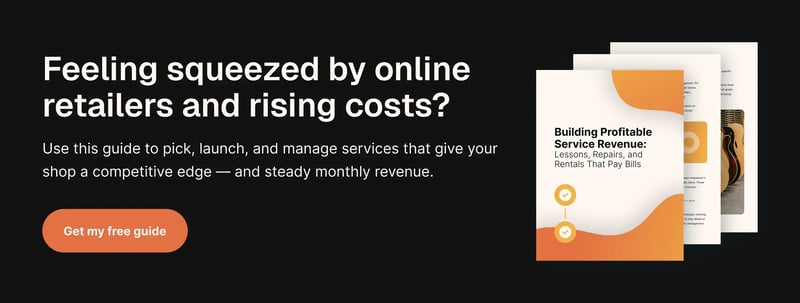
Effective music store strategies set your music store apart from the competition — they’re your competitive edge.
As a music retailer, your mission isn't just to sell instruments — it's to stay on top of new strategies that transform your store into a community that creates unique experiences for your customers.
In this blog, we'll explore five essential music store strategies designed to enhance customer satisfaction and encourage repeat business.
Let’s get started.
Strategy #1: Understand and Engage with Music Customers
Knowing what today's music customers want is an important part of running a successful music store. But engaging with your audience goes beyond just recognizing their needs — you need to make each interaction memorable and meaningful.
To get started, focus on understanding their preferences and utilizing effective engagement techniques:
- Leverage social media: Use platforms like Instagram to interact with customers, sharing content that resonates with their musical interests and encourages them to participate in discussions or challenges.
- Host community events: Organize local events, like open mic nights or music workshops, that invite customers to connect with each other and your business on a deeper level.
Put an emphasis on these strategies to ensure your customers feel connected and valued. This will strengthen their loyalty to your store and create a sense of community. Remember: It’s these interactions that build relationships and keep customers coming back to your music store.
Strategy #2: Enhance In-Store Musical Experiences
Creating an inviting and interactive in-store environment is a great way to set your music store apart. Your space should be more than just a place to buy instruments — it should be a destination where musicians feel inspired and welcomed.
To achieve this, consider these strategies for crafting unique in-store experiences:
- Interactive setups: Organize instruments and equipment in a way that encourages customers to try them out. Design your store so that the shopping experience feels like a discovery journey.
- Themed sections: Create dedicated areas that showcase different music genres or eras, sparking curiosity and inviting exploration. For example, feature sections with music from the '70s or '80s to capture diverse interests.
Transform your music store by focusing on these elements. Remember: A memorable in-store experience not only enhances satisfaction, but also builds a community of loyal customers.
Related Read: Music Store Layout: 8 Design Ideas To Consider
Strategy #3: Prioritize Convenience for Musicians
Convenience is a powerful way to boost customer satisfaction in your music store. By creating a seamless and effortless shopping experience, you encourage musicians to choose your store for all their needs.
Consider these approaches to improve convenience:
- Streamlined services: Introduce user-friendly online reservation systems for in-store pickups for purchasing essential music supplies. These features save customers time and simplify their shopping journey.
- Personalized assistance: Provide personalized shopping assistance to help customers quickly find the items they need while ensuring they feel valued and understood.
- Community-centric services: Offer local delivery options for customers who might have difficulty visiting the store. This also demonstrates your support for the local music community.
These convenient and personalized services create an inviting shopping experience that customers can depend on. By focusing on ease and community connection, your store becomes a trusted choice that encourages repeat visits.
Strategy #4: Offer More Than Just Instruments
Providing value beyond the products you sell is an excellent way to differentiate your music store. When you offer additional services, you build deeper connections with your customers and improve their overall experience.
Here are some ideas to expand your offerings:
- Music lessons and workshops: Set up music lessons or skill-enhancement workshops tailored for different age groups and proficiency levels. This approach not only attracts more visitors, but establishes your store as a center for music education and growth.
- Instrument maintenance clinics: Organize regular clinics where customers can learn proper instrument care or receive professional tune-ups, offering added value to their purchases.
- Rental services: Introduce rental options for instruments and equipment to allow customers to try new gear without the immediate need to purchase.
Moving beyond just selling products, these services transform your store into a dynamic community space where musicians can learn, connect, and grow. This strategy increases loyalty and encourages repeat visits, ensuring your music store is a destination — not an afterthought.
Related Read: How To Manage Musical Instrument Rentals: 9 Tips & Tools
Strategy #5: Integrate Music-Friendly Technology Solutions
Integrating technology that resonates with the needs of customers can greatly enhance the functionality and appeal of your music store. Using the right tech solutions, you can streamline operations and improve the overall customer experience.
Implement these technology-driven strategies:
- Music-focused point of sale (POS) system: Utilize a music-specific point of sale system that tracks inventory by genre or artist, ensuring that your stock levels are always aligned with customer demand and preferences.
- In-store music streaming: Incorporate music streaming services in store to create an engaging and dynamic shopping environment that resonates with your customers’ tastes.
- Interactive apps and software: Give customers access to music apps or software that help them explore instruments and learn about their features, enhancing their buying experience.
These technology solutions improve operational efficiency and the shopping experience, creating a modern, appealing environment. This tech-savvy approach helps your store stand out as a destination that caters to the needs of musicians.
Related Read: 6 Best Music Store Software Solutions [Features + Pricing]
Implement These Music Store Strategies With Music Shop 360
Implementing these five successful music store strategies not only elevates your store's appeal — it’ll create an engaging and memorable experience for your customers. By enhancing customer engagement, strengthening community connections, and utilizing music-friendly technologies, your store can remain competitive in the music retail market.
Music Shop 360 is here to support your music store. Our industry-specific POS tools are designed to streamline your store's operations, improve customer interactions, and give insights that allow you to tailor your offerings based on needs and preferences.
Schedule a demo of Music Shop 360 today to discover how our solutions can help you deliver exceptional service — all while building lasting relationships with your customers.




 by
by 







